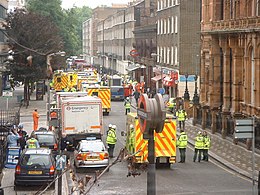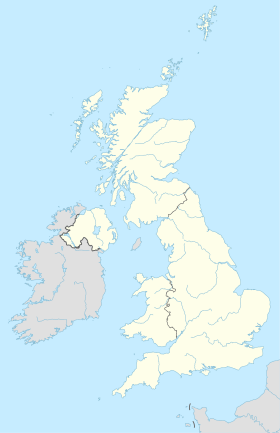July 7, 2005 London bombing
| 7 July 2005 London bombings | |
|---|---|
| Part of Terrorism in the United Kingdom and Islamic terrorism in Europe | |

Emergency services at Russell Square tube station on 7 July 2005
|
|
| Location | London, United Kingdom |
| Date | 7 July 2005 08:49 – 09:47 BST (UTC+01:00) |
| Target | General public aboard London Underground trains and a bus in central London |
|
Attack type
|
Suicide bombings, Islamic terrorism |
| Weapons | TATP |
| Deaths | 56 (including the 4 bombers) |
|
Non-fatal injuries
|
784 |
| Perpetrators |
Hasib Hussain Mohammad Sidique Khan Germaine Lindsay Shehzad Tanweer |
| Motive | Islamic terrorism |
The 7 July 2005 London bombings, often referred to as 7/7, were a series of coordinated terrorist suicide bomb attacks in London, United Kingdom, which targeted civilians travelling on the city's public transport system during the morning rush hour.
Four Islamic terrorists separately detonated three bombs in quick succession aboard London Underground trains across the city and, later, a fourth on a double-decker bus in . The train bombings occurred on the Circle line near Aldgate and at Edgware Road, and on the Piccadilly line near Russell Square.
Fifty-two people, all UK residents but of 18 different nationalities, were killed and more than 700 were injured in the attacks, making it Britain's deadliest terrorist incident since the 1988 bombing of Pan Am Flight 103 over Lockerbie, Scotland, as well as the country's first ever Islamist suicide attack.
The explosions were caused by homemade organic peroxide–based devices packed into backpacks. The bombings were followed two weeks later by a series of attempted attacks that failed to cause injury or damage. The 7 July attacks occurred the day after London had won its bid to host the 2012 Olympic Games.
At 8:49 am, three bombs were detonated on board London Underground trains within 50 seconds of each other:
It was originally thought that there had been six, rather than three, explosions on the Underground network. The bus bombing brought the reported total to seven; this was clarified later in the day. The erroneous reporting can be attributed to the fact that the blasts occurred on trains that were between stations, causing wounded passengers to emerge from both stations, giving the impression that there was an incident at each. Police also revised the timings of the tube blasts: initial reports had indicated that they occurred during a period of almost half an hour. This was due to initial confusion at London Underground (LU), where the explosions were originally believed to have been caused by power surges. An early report, made in the minutes after the explosions, involved a person under a train, while another described a derailment (both of which did occur, but only as a result of the explosions). A code amber alert was declared by LU at 09:19, and LU began to cease the network's operations, ordering trains to continue only to the next station and suspending all services.
...
Wikipedia


